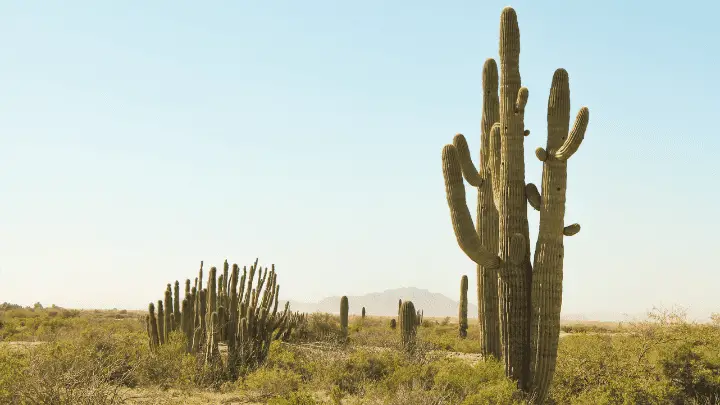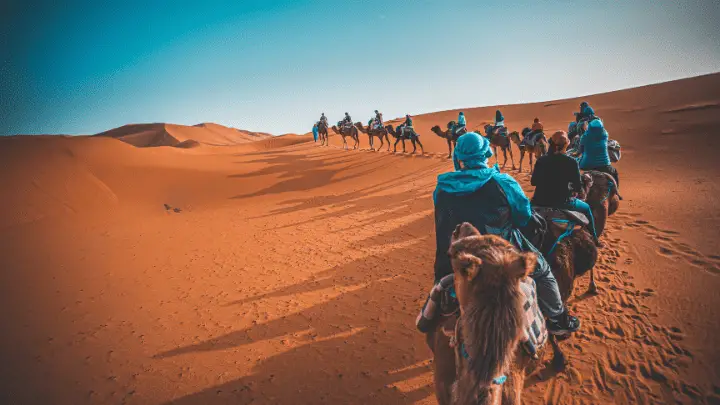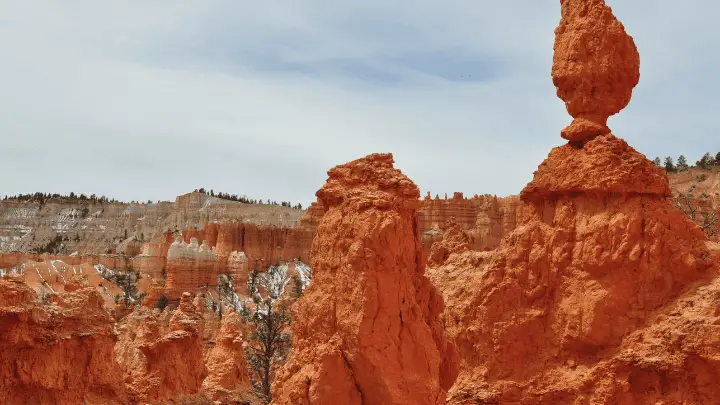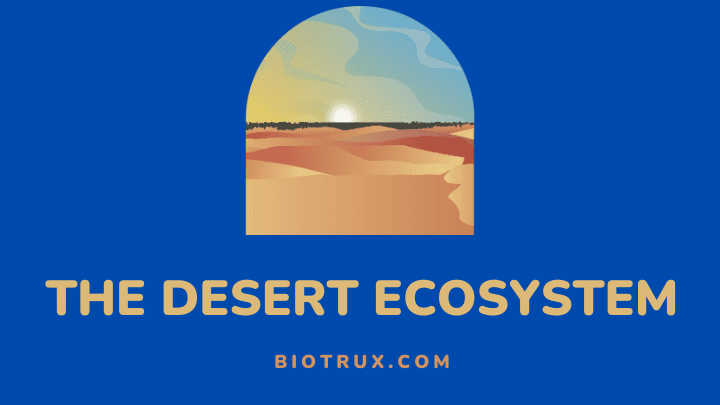The desert ecosystem is a striking and fascinating environment that covers vast regions of our planet. It has extreme temperatures, scarce water, and unique plants and animals adapted to survive in this harsh environment.
Here, you’ll learn more about desert ecosystems, the various types of deserts worldwide, and how these ecosystems have evolved to thrive.
I’ll also discuss some of the threats facing the desert ecosystem today and what we can do to help protect these incredible environments. So, let’s dive in and explore the wonders of the desert ecosystem.
What is the Desert Ecosystem?
A desert ecosystem is characterized by its lack of water and extreme temperature variations. In these areas, rainfall is scarce, and plant life is adapted to withstand long periods of drought.
The animals in this ecosystem also have special adaptations, such as storing water, burrowing underground to escape the heat, or coming out at night when it is cooler.
Despite the harsh conditions in the desert, it is home to a wide variety of unique and fascinating species.
Characteristics of Desert Ecosystem
Deserts may seem like barren, lifeless wastelands, but they are complex ecosystems that have evolved to thrive in harsh conditions. Here are seven key characteristics of desert ecosystems:
1. Extreme temperatures: Deserts can be scorchingly hot during the day and cold at night. Many plants and animals have adapted to these extreme temperature fluctuations.
2. Sparse vegetation: Plants in deserts are often widely spaced and adapted to conserve water by having small or waxy leaves.
3. Water scarcity: Rainfall is limited in deserts, making water a precious resource for plants and animals. Some animals have specialized ways of conserving water, such as producing very concentrated urine.
4. Adaptations for survival: Desert animals have evolved adaptations to help them survive in harsh conditions.
5. Dunes: Many deserts have vast dunes formed by the wind.
6. Minimal soil: The soils in deserts are often shallow and nutrient-poor, making it difficult for plants to grow. Some desert plants have adapted to grow in the gaps between rocks, where soil may accumulate.
7. Biodiversity: Although deserts may seem bleak, they are home to various plant and animal species, including some found nowhere else on Earth.
Adaptation of the Desert Ecosystem
One of the most remarkable things about the desert ecosystem is the incredible ability of its inhabitants to adapt to the harsh, arid conditions. Some animals and plants can survive for weeks without water in the desert, such as camels and plants that store water in their leaves.
Plant life in the desert

While many might assume that the desert is a barren wasteland devoid of plant life, this couldn’t be further from the truth. The desert has various plant species, each with unique survival adaptations. Some examples include:
- Succulents: These plants have thick, fleshy leaves that allow them to store water for long periods. Examples include cacti and agave.
- Xerophytes: These plants have evolved the ability to conserve water by reducing the size of their leaves and growing deep roots. Examples include sagebrush and mesquite.
- Annuals: These plants complete their entire lifecycle within the brief window of time when rain is available. Examples include desert sunflowers and evening primrose.
Animal life in the desert

The animal life of the desert is just as fascinating as its plant life. From reptiles that bask in the sun to nocturnal mammals that hunt under cover of darkness, the animals of the desert have evolved a wide range of strategies for survival.
- Reptiles: Snakes, lizards, and other reptiles are well-suited to the desert’s extreme temperatures. They can regulate their body temperature by basking in the sun or retreating to the shade.
- Birds: Many bird species are migratory, traveling to the desert during winter to take advantage of its relatively mild climate. Others, like the roadrunner, are year-round residents.
- Mammals: Desert mammals include jackrabbits, kangaroo rats, and coyotes, among others. Many of these animals are nocturnal, coming out to hunt or forage under darkness when temperatures are cooler.
The geology of the desert

The desert is also home to some of the most unique geological formations on the planet. From towering dunes to ancient rock formations, the desert has been shaped by millions of years of wind and water erosion.
- Dunes: These massive formations are created by wind-blowing sand grains across the desert landscape. The largest dune fields in the world can be found in the Sahara and the Arabian Peninsula.
- Canyons: Canyons are formed by water erosion, as rivers and streams carve away at the rock over millions of years. The Grand Canyon in Arizona is one of the most famous examples of a desert canyon.
- Rock formations: The desert has various unique rock formations, including hoodoos, mesas, and buttes. These rock formations provide significant habitats for various plant and animal species, and they are also popular destinations for tourists and outdoor enthusiasts. Some of the most famous rock formations in the world can be found in desert regions, such as Monument Valley in the United States. In addition, Wadi Rum in Jordan.
Types of Desert Ecosystem
Deserts are harsh and challenging environments for any organism to survive in. However, there are four main types of desert ecosystems. These are hot and dry, semiarid, coastal, and cold.
1. Hot and dry desert ecosystem
Most people think of the hot and dry desert ecosystem when they hear “desert.” It’s characterized by high temperatures, low precipitation, and a scarcity of vegetation.
Some well-known hot and dry desert ecosystems include the Sahara Desert in Africa and the Mojave Desert in the United States.
2. Semiarid desert ecosystem
The semiarid desert ecosystem receives slightly more precipitation than the hot and dry desert, but it’s still an extremely arid environment.
The temperatures are still high but have low humidity, making the climate more bearable for some organisms. The Chihuahuan Desert in the southwestern United States and northern Mexico is a classic example of a semiarid desert ecosystem.
3. Coastal desert ecosystem
Coastal deserts are found along the western coastlines of continents. They receive cool, moist air from the ocean, but the mountains along the coast prevent the rain from reaching the inland areas.
This results in a unique desert ecosystem that’s relatively cooler and more humid than other deserts. Some examples of coastal desert ecosystems include the Atacama Desert in Chile and the Namib Desert in southern Africa.
4. Cold desert ecosystem
These are located at high latitudes or altitudes, where the temperatures are low, and the precipitation is very low. The vegetation in cold deserts is mostly limited to grasses and shrubs.
Some examples of cold desert ecosystems include the Gobi Desert in Mongolia and the Great Basin Desert in the western United States.
The Threats Facing the Desert Ecosystem
While the desert ecosystem is incredibly resilient, it is not invincible. Like all natural systems, it faces various threats that put its fragile balance at risk.
1. Climate change
One of the biggest threats facing the desert ecosystem is climate change. As temperatures rise and rainfall becomes more unpredictable, the delicate balance of life in the desert is being disrupted.
This can lead to changes in the timing of plant growth, alterations to animal migration patterns, and other impacts that can ripple through the ecosystem.
2. Habitat loss
As human populations continue to expand, the natural habitats of many desert species are being lost to development.
Roads, buildings, and other infrastructure projects can fragment habitats, making it more difficult for animals to move and forage. This can lead to declines in populations and even extinctions.
3. Invasive species
Invasive species are another major threat to the desert ecosystem. Non-native plants and animals can outcompete native species for resources, disrupting the ecosystem’s delicate balance. In some cases, invasive species can cause ecosystem-wide changes that are difficult to reverse.
FAQs
How do desert animals survive without water?
Many desert animals have evolved adaptations allowing them to go without water for long periods. For example, camels can store water in their humps, while kangaroo rats can extract water from the seeds they eat.
Are deserts always hot?
No, deserts can be hot or cold, depending on their location and altitude. Some desert regions, such as the Gobi Desert in Mongolia, can be quite cold, with temperatures dropping below freezing at night.
Can humans live in the desert?
Yes, humans have been living in desert regions for thousands of years. However, the desert requires specialized knowledge and adaptations to the harsh environment.
How can we protect the desert ecosystem?
Protecting the desert ecosystem requires a multi-pronged approach. They include reducing greenhouse gas emissions to combat climate change, protecting habitats from development, and preventing invasive species from spreading.
Final Thoughts
One of the most interesting things about the desert ecosystem is the incredible ability of plants and animals to adapt to harsh conditions. From the camels that store water in their humps to the cacti that store water in their stems, each organism has developed unique adaptations to help them survive.
However, this unique ecosystem is threatened by human activities such as mining, agriculture, and urban development. We must do our part to protect these fragile habitats and the species that call them home.
Overall, the desert ecosystem is a testament to the resilience and adaptability of nature. It is a reminder that life can thrive even in the harshest conditions. Let us appreciate and protect this vital ecosystem for generations to come.
You can also learn more about why the ocean is important to us.
Thanks for reading.

